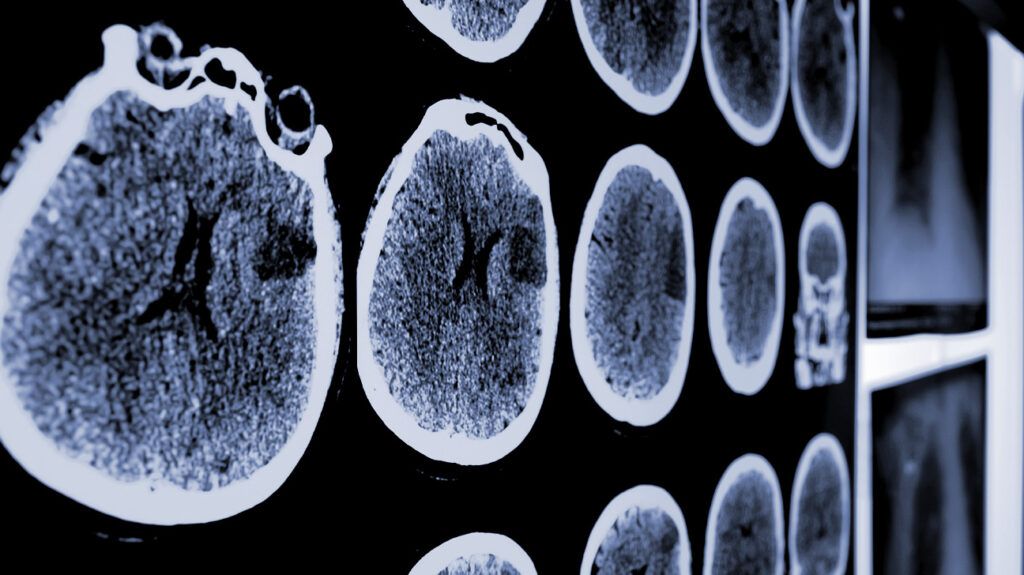Schizophrenia is a mental health condition that may affect feelings, thoughts, and behaviors. However, some MRI and CT brain scans of people with schizophrenia may also show physical changes.
Symptoms of schizophrenia can vary. They can affect every aspect of a person’s life. It is a lifelong condition that requires ongoing treatment.
According to the
This article discusses how brain scans can detect schizophrenia, brain changes due to schizophrenia, and how the condition can affect the brain over time.

Brain scans can detect physical changes linked to schizophrenia. Researchers use magnetic resonance imaging scans (MRIs) to examine the physical changes that can occur in the brain of someone with schizophrenia. The MRIs create detailed images of the whole brain.
Different types of MRIs have shown different structures and pathways that schizophrenia may affect. Functional MRIs measure differences in blood flow through the brain. They have shown that the brains of people with schizophrenia may use blood sugars differently for energy, according to a
A type of MRI called diffusion tensor imaging (DTI) has detected changes in the brain’s white matter in people with schizophrenia, according to a
A 2021 review suggests that positive emission tomography (PET) scans show how messenger chemicals (neurotransmitters) transmit less effectively between the brain regions of people with schizophrenia than those without.
However, even though brain scans can show these changes may have a link to schizophrenia, they cannot predict whether a person will definitely develop the condition or whether they already have it.
Depending on the type of brain scan, schizophrenia produces different physical effects that show up in several ways.
The brain has two different types of matter: white and gray. Schizophrenia may cause changes in both.
Gray matter
White matter’s
Schizophrenia may alter the size, shape, and function of these types of matter.
White matter
A
The researchers explain that reduced white matter integrity may have a link to reduced cognitive processing speed.
In a
Schizophrenia has also shown an increase in the number of a type of neuron called interstitial white matter neurons, located just below the cortex. Scans have shown changes to the density of different brain regions and types of brain matter, but the results are inconsistent. More research is necessary to show consistent white matter changes due to schizophrenia.
Gray matter
Schizophrenia has also shown some effect on gray matter in physical scans.
It may reduce the surface area and volume of gray matter and thin it out in the prefrontal and temporal lobes, according to
Gray matter changes link to thinking and movement and may also affect how people store and retrieve words. These changes can worsen over time and may have more effect on the following:
- people with untreated schizophrenia
- those with more severe schizophrenia
- individuals who first experience symptoms of schizophrenia at a young age
Aside from changes to the physical structure, schizophrenia can also affect how neurotransmitters travel across the brain. Neurotransmitters convert electrical signals in the brain to chemicals
These do not appear on MRI scans, as MRIs only show physical structures in the brain. Instead, PET scans can show how neurotransmitters travel across the brain and affect different areas of it.
Dopamine
Dopamine is a neurotransmitter that is associated with the brain’s reward system. It also has links to the control of body movements.
A
The researchers connected this with positive symptoms such as disordered body movements. It might also have links to psychosis and cognition problems in schizophrenia.
Other chemicals
There are fewer studies supporting the effects of schizophrenia on other neurotransmitters, but theoretical connections might exist. Research from 2018 found that some studies hypothesize the possibility of schizophrenia’s involvement with two other neurotransmitters: serotonin and glutamate.
Serotonin plays a role in sleep, mood, memory, and appetite control. The above study suggests that excess serotonin can contribute to psychosis. It can also release glutamate, a neurotransmitter that activates the neurons it reaches. In people with schizophrenia, the receptors that glutamate binds to may not work as usual.
This leaves too much glutamate moving around the brain between the synapses. This may have a range of effects, including cognitive and memory symptoms.
Schizophrenia is connected to brain changes over time, even after treatment.
However, a
As the condition progresses, different areas of the brain may lose gray matter thickness and undergo physical changes. For example, people with early schizophrenia
- the occipital lobe
- the frontal lobe
- the superior parietal lobe
- the temporal lobe
It is not clear whether these changes are causes or effects of schizophrenia.
The following are answers to some questions people frequently ask about schizophrenia and brain scans.
What type of scan shows schizophrenia?
MRI, PET, and DTI scans can all show different physical effects of schizophrenia.
Can a brain scan show mental health disorders?
Schizophrenia is not the only mental health condition that may show on brain scans. According to
Some effects of schizophrenia are visible on MRI, PET, and DTI scans. The mental health condition causes structural changes to the gray and white matter of the brain, both in the tissue density and how the brain functions. MRI scans can show these changes.
Schizophrenia-linked neurotransmitter changes, such as dopamine increases, might also show on PET scans.
